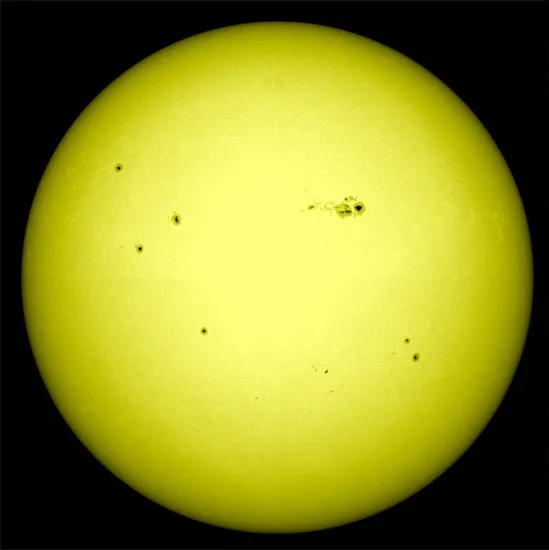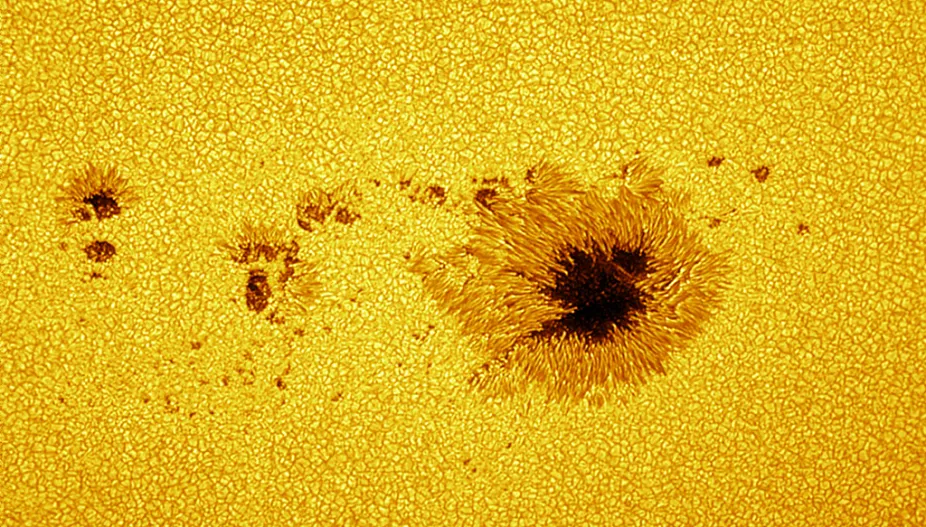The Surface of the Sun

This color enhanced view of the Sun shows sunspots on the surface, or photosphere, of the Sun. Though the visible light emitted by the Sun is actually white light, we often perceive sunlight as yellow due to scattering of shorter, blue wavelengths as light passes through the atmosphere.
NASA
The surface of the Sun is called the photosphere, a term which means “sphere of light.” The glowing ball of light that you see in the sky is the photosphere. The surface of the Sun is the only part that we can see from Earth on a typical day, without use of specialized equipment.
The Photosphere is Cooler Than the Layers Around It
The photosphere is a thinner, cooler layer than its neighboring layers. It is only about 500 km (300 miles) wide, a much thinner layer than the interior solar regions. The temperature of the photosphere is around 5,500 °C (9,900 °F), which is much cooler than the Sun's core. Most of the light energy produced in the Sun’s core escapes from the photosphere. Because the plasma is cooler and less dense at the surface, there are fewer collisions to trap the energy carrying photons within the Sun. Instead, energy radiates away through space, some of it reaching Earth.
Surprisingly, the photosphere is also much cooler than the atmosphere above it, which has regions with temperatures as hot as 2 million °C (3.5 million °F). There is some variation in temperature from place to place within the photosphere – for example, sunspots are relatively “cool” regions with temperatures as low as 3,000 °C (5,400 °F).
What’s on the Surface of the Sun?
Sunspots, indicators of disturbed magnetic fields, are the most common features seen in the photosphere. Sunspots are generally surrounded by lighter areas called faculae. Observing sunspots drift across the surface helped astronomers discover that the Sun actually rotates on its axis – the polar regions take longer to complete a rotation than the equatorial regions because the Sun isn’t solid.

Surrounded by glowing plasma, sunspots are planet-sized dark areas on the surface of the Sun. Granulation, appearing similar to bubbles, is due to convection currents in the solar interior.
Michael Teoh/Heng Ee Observatory
Close-up views of the photosphere also show patterns of light areas surrounded by darker borders, called granulation. Similar to the patterns you can see at the top of a pot of boiling water, granulation is caused by heat rising to the photosphere from the hotter solar interior. Where the hot, rising blobs of plasma reach the surface, we see bright areas. The darker boundaries of the granulation cells are places where the plasma has cooled and is sinking back into the Sun's interior.
The active regions around sunspots often cause solar flares, which are explosions of radiation that extend hundreds of thousands of miles above the Sun's surface, producing bursts of X-rays, ultraviolet radiation, and radio waves. Solar flares are just one example of how activity on the surface of the Sun can affect the entire solar system, including Earth.